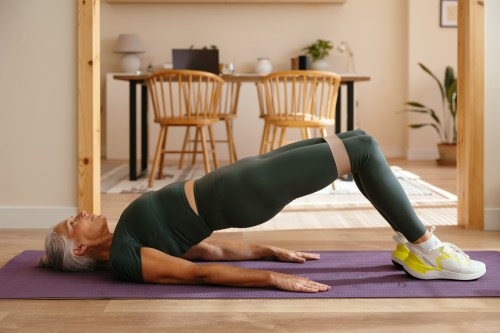‘I’m a Cardiologist and a Bollywood Dance Fitness Instructor, and This Is Why Dancing Is One of the Best Things for Heart Health’
If you've ever wondered "does dancing count as cardio," learn four reasons why a cardio expert recommends getting your boogie on.

You could say that Amar Shere, MD, is used to practicing the heart-health advice he preaches—and then some. The multitalented physician, who’s a cardiologist with Atlantic Health System moonlights as a Bollywood dance fitness instructor in his (limited) free time. In 2022, Dr. Shere even sailed through three rounds of high-stress competition on the NBC series Dancing With Myself.
Experts in This Article
And when he’s not dancing or seeing patients, Dr. Sheere shares an unexpected, highly entertaining mix of dance clips, salutes to his Indian-American heritage, and actionable tips for improving cardiovascular health with his 120K TikTok followers.
Want to get in on the heart-health happy dance? Here are Dr. Shere’s top four reasons why dancing should play a starring role in your regular heart health routine.
1. Dancing is (often) aerobic exercise
“Many structured dance [fitness] classes are exactly the type of exercise the American Heart Association (AHA) recommends: sustained, moderate aerobic exercise for at least 30 minutes at a time,” Dr. Shere says. Go to class five times a week, and you’ll be passing those AHA guidelines with flying colors.
Here, moderate exercise means continuous movement that requires a medium amount of effort. “Aerobic exercise is any form of exercise that increases your heart rate, so that eventually you’ll improve your cardiovascular fitness,” Dr. Shere explains.
Not sure if you’re dancing at a moderate intensity? Your breathing and heart rate will be faster than when you’re at rest, but you’ll still be able to carry on a conversation without excessive effort.
2. Dancing can improve your lipid profile
Let’s talk about cholesterol. As Dr. Shere says, “Regular exercise, like dancing, has been shown to positively impact your lipid profile,” which is a test cardiologists use to measure different types of fat in your blood.
According to Dr. Shere, “Habitual aerobic dancing can increase your high-density lipoprotein cholesterol (aka HDL, or ‘good,’ cholesterol) and manage or lower your low-density lipoprotein cholesterol (aka LDL, or ‘bad,’ cholesterol).” LDL cholesterol is the kind that contributes to plaque buildup in your arteries, which often leads to heart disease. So anything that decreases it is a surefire heart-healthy choice.
3. Dancing relieves stress
“Negative mental-health symptoms like stress definitely have an impact on your heart,” Dr. Shere says. “There are actually forms of heart failure that can happen from long-term exposure to emotional stress that weakens the heart muscle.”
Periodically taking time to dance it out could help shield your ticker from long-term effects of stress. For maximum benefit, pick a dance style and musical genre that make you feel happy and relaxed.
4. Dancing is for everyone
“Dance not only helps your heart and your overall health,” Dr. Shere says. “It’s also really fun.” No matter your interests, time or financial constraints, ability, or current level of physical fitness, there are dance offerings out there that would be a perfect fit for you.
“When I talk about exercise with my patients, I always tell them that the ‘best’ exercise is something that you enjoy and can stay consistent with,” Dr. Shere adds. “If you’re not going to enjoy it, you’re not going to do it. Dancing is nothing to be scared of, and it’s not a chore. Celebrate the joy of expressing yourself through movement, and enjoy the heart-health benefits that come with it.”
Ready to get your groove on? Try this 10-minute cardio dance routine:
Does dancing count as cardio?
Cardio exercise is any form of movement that increases your heart rate and gets you breathing harder, according to Harvard Health. Dancing definitely checks that box. To see health benefits from this type of workout, it’s recommended you get 150 minutes of moderate-intensity activity or 75 minutes of vigorous-intensity activity per week, according to the Centers for Disease Control and Prevention (CDC).
What exactly does that mean? In simplest terms, moderate-intensity exercise is anything where you can still carry on a conversation or sing along to your favorite song, but it’s a bit difficult, per the CDC. Vigorous-intensity exercise, on the other hand, is anything where you won’t be able to to say more than a few words without needing to stop and take a breath.
If you’re wearing a heart rate monitor, moderate physical activity is anything that gets you to 50 to 70 percent of your maximum heart rate and vigorous physical activity is anything that’s 70 to 85 percent of your maximum heart rate. (Even if you aren’t using tech, you can find an estimate of your maximum heart rate by subtracting 220 from your age, per the AHA.)
—reviewed by Jennifer Logan, MD, MPH
Sign Up for Our Daily Newsletter
Get all the latest in wellness, trends, food, fitness, beauty, and more delivered right to your inbox.
Got it, you've been added to our email list.










